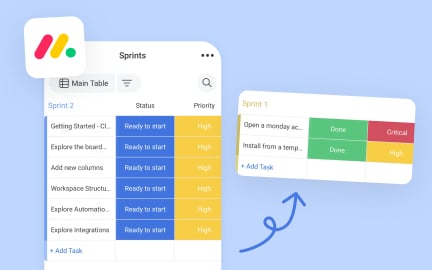Sprint Planning & Execution
Sprint planning and execution set short-term goals, align team efforts, and track progress in agile workflows to ship usable product features.
What is Sprint Planning & Execution?
Your development team struggles with unclear priorities and constantly shifting objectives because sprint planning doesn't create realistic commitments or clear focus that enables productive development work within time constraints.
Most teams conduct sprint planning as a scheduling exercise rather than strategic commitment-making that aligns team capacity with business priorities while creating achievable objectives that teams can actually deliver successfully.
Sprint planning and execution is the systematic process of defining realistic development objectives for short time periods, allocating team capacity effectively, and managing work execution to deliver valuable outcomes within sprint timeframes through focused collaboration.
Teams with effective sprint planning and execution achieve 60% higher velocity, 45% better predictability, and significantly improved stakeholder satisfaction because sprints consistently deliver valuable results rather than leaving work incomplete or goals unclear.
Think about how successful software companies use sprint methodologies to coordinate development teams around clear objectives while maintaining flexibility to adapt to changing requirements, or how product teams use sprints to balance feature development with technical improvements systematically.
Why Sprint Planning & Execution Matter for Development Success
Your development work lacks focus and predictability because sprint planning doesn't create realistic commitments based on team capacity and work complexity, leading to frustration when goals aren't achieved and stakeholder expectations aren't met.
The cost of poor sprint planning and execution compounds through every development cycle. You get missed commitments, unclear priorities, team stress from unrealistic expectations, and stakeholder frustration when development doesn't deliver promised outcomes predictably.
What effective sprint planning and execution deliver:
Higher development predictability because systematic planning creates realistic commitments based on team capacity and work complexity rather than optimistic estimates that set teams up for failure.
When sprint planning reflects actual team capability, development feels manageable and stakeholders can depend on delivery commitments rather than hoping work gets completed.
Better priority focus through sprint objectives that align team effort around the most important outcomes rather than spreading attention across too many competing priorities that prevent meaningful progress.
Improved team collaboration because clear sprint goals create shared understanding of objectives and individual responsibilities that enable effective coordination without confusion.
Enhanced stakeholder confidence as consistent sprint delivery builds trust in development team capabilities and creates reliable planning foundation for business decision-making.
Faster learning and adaptation through sprint retrospectives that identify improvement opportunities and optimize team performance based on actual experience rather than theoretical best practices.
Advanced Sprint Planning & Execution Strategies
Once you've established basic sprint capabilities, implement sophisticated sprint optimization and scaling approaches.
Cross-Team Sprint Coordination: Coordinate sprints across multiple teams to optimize dependencies and shared objectives while maintaining team autonomy and focus.
Stakeholder Sprint Engagement: Include stakeholders in sprint planning and review processes that build alignment without disrupting development team focus and productivity.
Sprint Metrics and Performance Optimization: Use sprint data and analytics to identify improvement opportunities and optimize team performance based on objective measurement rather than subjective assessment.
Adaptive Sprint Planning: Adjust sprint planning approaches based on work type, team maturity, and business context rather than using rigid sprint processes regardless of situational differences.
Recommended resources
Courses

Accessibility Foundations

Wireframing

Introduction to Figma
Lessons

Agile Ceremonies

How Product Can Adopt Agile









